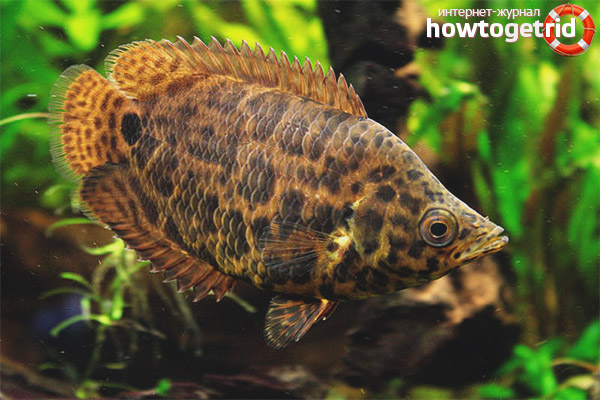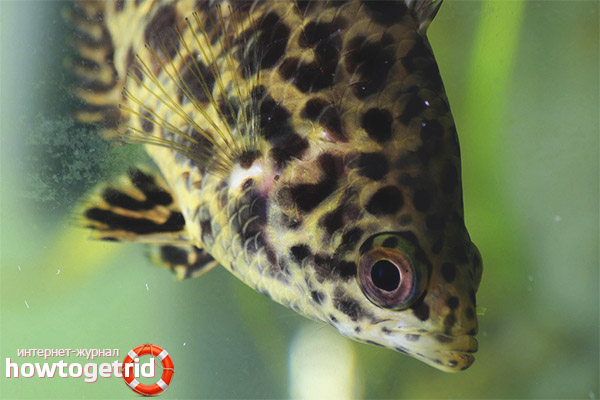The content of the article
A leopard xenopoma looks rather strange when a person sees it for the first time. But after some observations, interesting habits in the behavior of aquatic pets are noted. Naturally, the fish got its name because of the specific color with spots. Representatives of the family are met in Africa. As a rule, fish prefer slowly flowing rivers, but they may well exist in fast-flowing water sources. Leopard ktenopomes appeared a long time ago, they began to be kept in aquarium conditions since 1955.
Description
Habitat - Africa, Congo River Basin. In these open spaces fish can be found everywhere, starting with ponds with stagnant water and ending with fast-flowing rivers.
Representatives of the family have an oval-shaped case, they are flat, high. Fins are located around the entire perimeter of the body. The fish are dark green with shapeless spots and huge eyes. Since ktenopomes are predators by nature, they require camouflage, this provides a full color.
Due to their leopard pattern, the fish are masked in the dark or light water between the vegetation. They like to swim among foliage and other types of thickets. Fish swim at the bottom, rarely climb to the surface. Awake at night, and during the day doze off or are in a sluggish state.
In their natural conditions, fish grow up to 20 cm, but in the aquarium, representatives of the family hardly reach 12-15 cm. This is due to the compression of space and a different diet.
No special difficulties in content. The main thing is to choose the right neighbors for the fish, provide them with quality food and adhere to the required parameters of the aquatic environment.
Representatives of this family are quite difficult to distinguish in terms of gender. In males, a greater number of spines on the gills can be observed. They also have a coarser structure at the base of the tail. In females, such symptoms are usually absent.
Content
- The peculiarity of this subspecies is that members of the family do not recognize small comrades. They act as a pleasant snack. Xenopomas are irresponsible, they are dismissive of their own likeness and future offspring. In the neighbors you need to choose only large fish that can pacify leopards.
- Fish will feel fine in a spacious aquarium, that is, about one liter should be about one individual. water. Without fail, the dwelling is covered with a lid so that the fish do not jump out of it. The aquarium is not filled with water to the brim, you need to leave 3-5 cm.
- Lamps with scattering light are installed. From the ground, preference is given to fine pebbles or coarse-grained sand. Since fish like to be in shelters, it is imperative to install grottoes, driftwood, clay pots, locks, pipes, etc.
- From plants, it is necessary to give preference to species floating on the surface of the water. Subsequently, the fish will spawn upstairs. It is also worth planting a lowland in the aquarium so that the ctenopomies can hide. With all this fullness in the aquarium should be spacious enough for active swimming.
- Strictly adhere to the temperature regime, which is at around 23-28 degrees. Hardness is just as important (7 units) as well as acidity (6.5 units). All this will allow the fish to exist in comfort.
- A weekly fluid change is carried out in the amount of a quarter of the total volume. That is, they drained the water, added a new one. Naturally, we must not forget about installing filters for cleaning. These fish have low immunity, so peat extract is added.
Food
- Ktenopomy belong to omnivorous representatives of aquatic inhabitants. They are active predators. Such individuals feed on small fish, fry, amphibians and insects. Therefore, in aquarium conditions, individuals can eat live food without problems. In addition, they will eat artificial feed without any problems.
- It is recommended to feed the individuals in question with small fish, a tubule maker, earthworms and bloodworms. It is also allowed to give fresh-frozen food. In this case, take a look if the fish like this product.
Compatibility
- Can not be called aggressive fish, they are rather harmful, not accepting outsiders. Due to the inherent instinct of the predator, leopards eat small fish. Therefore, as a neighborhood, large individuals are selected that can fight back.
- Flocking fish, such as glossy tetras or catfish, should be chosen as optimal roommates. Golden Congo, barbs, African butterfly fish, polypteruses are also suitable.
- Ktenopoma behaves boldly only with the smallest individuals. She is afraid of huge individuals, they should not be planted. Well, if you fill the aquarium immediately with all kinds of inhabitants.
Breeding
- To get a couple that will reproduce offspring, it is recommended to keep several young individuals in the aquarium. As soon as the fish begin to grow up, they will pick up a pair for themselves. Keep in mind that in a separate aquarium for spawning there must be a large number of plants that will float on the surface.
- In this case, the aquarium should be covered with a dense mesh or a special cover. Fry should have access to warm, moist air, which will be located above the surface of the water. Caviar throwing occurs in a rather familiar way for representatives of the maze.
- Eggs have positive buoyancy, which is why they accumulate on the surface. It is worth noting that after spawning, parents do not particularly care about offspring. Therefore, after a couple, you can safely transplant into a common aquarium. After only two days, the fry begin to swim freely in the aquarium.
- In the first days after birth, fry are recommended to be fed with ciliates. After this, artemia nauplii is gradually allowed. It should be noted separately that the fish in question often spawn. In this case, the number of eggs can reach up to several thousand. Unfortunately, few fry survive in aquarium conditions.
- The problem is that cannibalism is developed among these fish. Stronger fry eat weak ones. It is also worth knowing that such fish breed seasonally. In the wild, ktenopomas can spawn for several months. They stop as soon as the rainy season begins.
- Such representatives of fish reach puberty rather late. It is believed that this occurs between the ages of 5 and 10 years. Such fish are considered ideal for beginners. Ctenopomas can live up to 15 years. In addition, such fish are very persistent with a rather interesting behavior.
Ktenopomy quite interesting representatives of fish. They are real predators. Therefore, it is not necessary to hook small aquarium inhabitants to them. Provide fish with good conditions. Feed a varied diet.
Video: Ctenopoma leopard (Ctenopoma acutirostre)












Submit